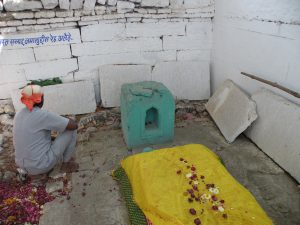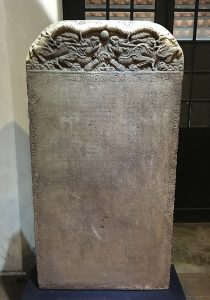Udaypur tri-lingual stepwell inscription dated 1645 CE
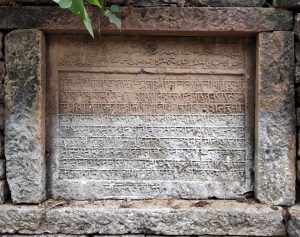
Udaypur (Madhya Pradesh). Stepwell inscription in Arabic, Persian and Sanskrit.
On a stone slab affixed into the right side wall of a stepwell known as Qanungo Baoli, located on the eastern outskirts of Udaypur, Vidisha District, Madhya Pradesh. A tri-lingual inscription of 13 lines carved in relief with the first three lines written in Arabic and Persian in nastaʿlīq script, and the next ten lines written in Sanskrit in nāgarī script. It records the construction of the stepwell by Gokuladāsa and Dāmodaradāsa, sons of Qānungo Haridāsa of Māthura kāyastha family, during the reign of Mughal emperor Shāhjahān (r. 1628-58). The date is given in three different eras—vikrama saṃvat 1701, śaka 1566 and hijri 1054—equivalent to Friday, 13 January, 1645 CE.
Dhar Inscription of Dilawar Khan dated AH 795
Dhār Inscription of Dilāwar Khān dated AH 795.
IN03151 Galle Trilingual Stele – Persian Inscription
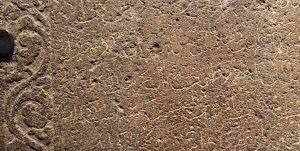
Galle (Sri Lanka). Stele of Zheng He (鄭和), detail of Persian portion. (Zenodo).
The inscription is engraved on a stone slab discovered in 1911 by H. F. Tomalin, the Provincial Engineer at Galle, in a culvert near the turn to Cripps Road within that town and afterwards moved to the Colombo Museum. The slab features inscriptions in three different languages, enclosed within a floral border: Tamil (top-left, IN03150), Persian (bottom-left) and Chinese (right, IN03152). The Persian inscription is dealt with here.
Following the discovery of the slab, the Chinese inscription was successfully transcribed and translated by Edmund Backhouse. However, Rao Bahadur H. Krishna Sastri (Assistant Superintendent for Epigraphy, Madras) and J. Horrovitz (Epigraphist for Moslem Inscriptions in India) failed in their efforts to decipher the Tamil and Persian texts respectively. Sometime later, the Tamil inscription was transcribed and translated for the third volume of Epigraphia Zeylanica (1933: 331–341) by Senarath Paranavitana, who benefitted from having access to Backhouse’s translation of the Chinese text. The Persian inscription is badly damaged but Khwaja Muhammad Ahmad of the Archaeological Department of H. E. H. the Nizam’s Dominions was able to compile a text and translation of the legible portion, which was published in 1933 as an appendix (Appendix B) to Paranavitana’s account of the Tamil inscription.
Following the discovery of the slab, the Chinese inscription was transcribed and translated by Edmund Backhouse. Like the Tamil inscription, it is dated in the second month of the seventh year of Yongle (永樂), the Chinese emperor whose reign began in 1403. The text features praise and offerings dedicated by the Chinese emperor, through his envoys Ching-Ho and Wang Ch’ing Lien, to the Buddha. The other two inscriptions on the slab feature similar lists of offerings but the beneficiary is different in each case, being a Hindu cult deity in the Tamil text and an Islamic saint or shrine in the Persian. It therefore appears that, when the Chinese arrived in Sri Lanka, they made gifts of equal value to several different religious traditions of the region and registered these gifts on the same stele.
OB03125 Galle Trilingual Stele of Zheng He (鄭和)
Udaypur उदयपुर (Madhya Pradesh). Arabic and Persian inscription (INAP00005) in a mosque (OBAP00005) near Chatua Darwaza
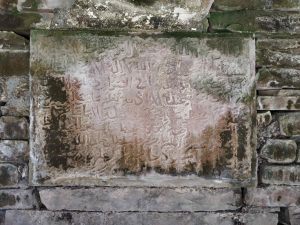
Arabic and Persian inscription (INAP00005) in a mosque (OBAP00005) near Chatua Darwaza recording the construction of the building by Khān-i ʿĀlam Jangi Khān in the time of Islām Shāh; working reading of the text 02/2020.
Udaypur उदयपुर (Madhya Pradesh). Mosque near Chatua Darwaza with an Arabic and Persian inscription (INAP00005)
Udaypur, उदयपुर (Madhya Pradesh).
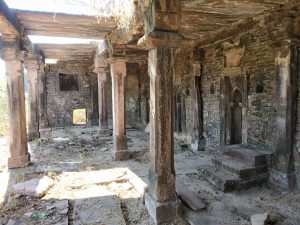
Mosque (OBAP00005) near Chatua Darwaza with an Arabic and Persian inscription (INAP00005) dated 1549 in the time of Islām Shāh of the Sūr dynasty.
Persian inscription of Jahāngīr dated AH 1027
Persian inscription (INAP00003) of Jahāngīr dated AH 1027 carved on a marble slab (OBAP00003).
Marble slab with a Persian inscription of Jahāngīr dated AH 1027
Nagaur Inscription of Muhammad bin Sam
Nagaur Inscription of Muḥammad bin Sām (d. 15 March 1206)
Nagaur Inscribed Slab of Muḥammad bin Sām
Nagaur Inscribed Slab of Muḥammad bin Sām of the Ghurid dynasty dated AH 594.
